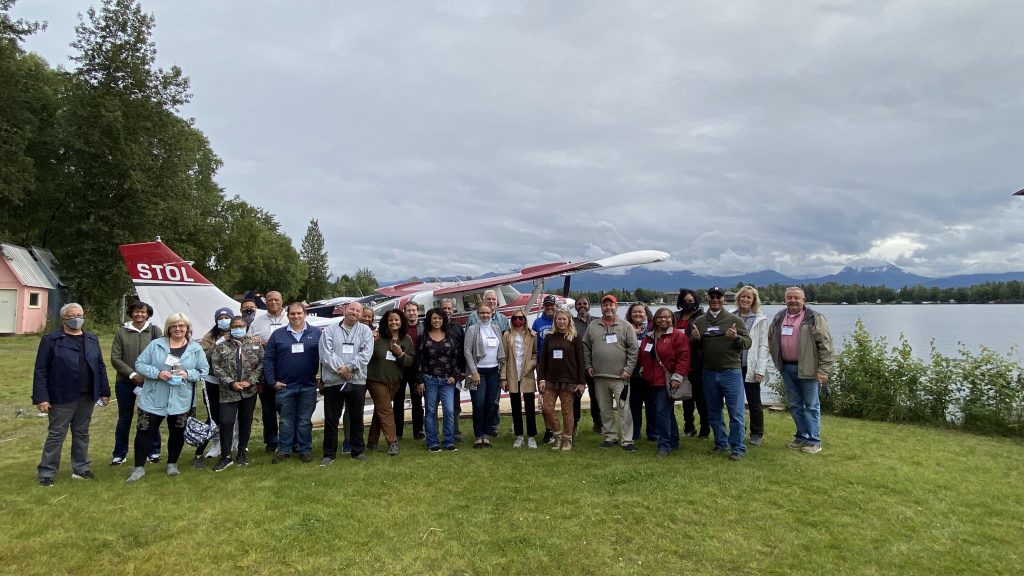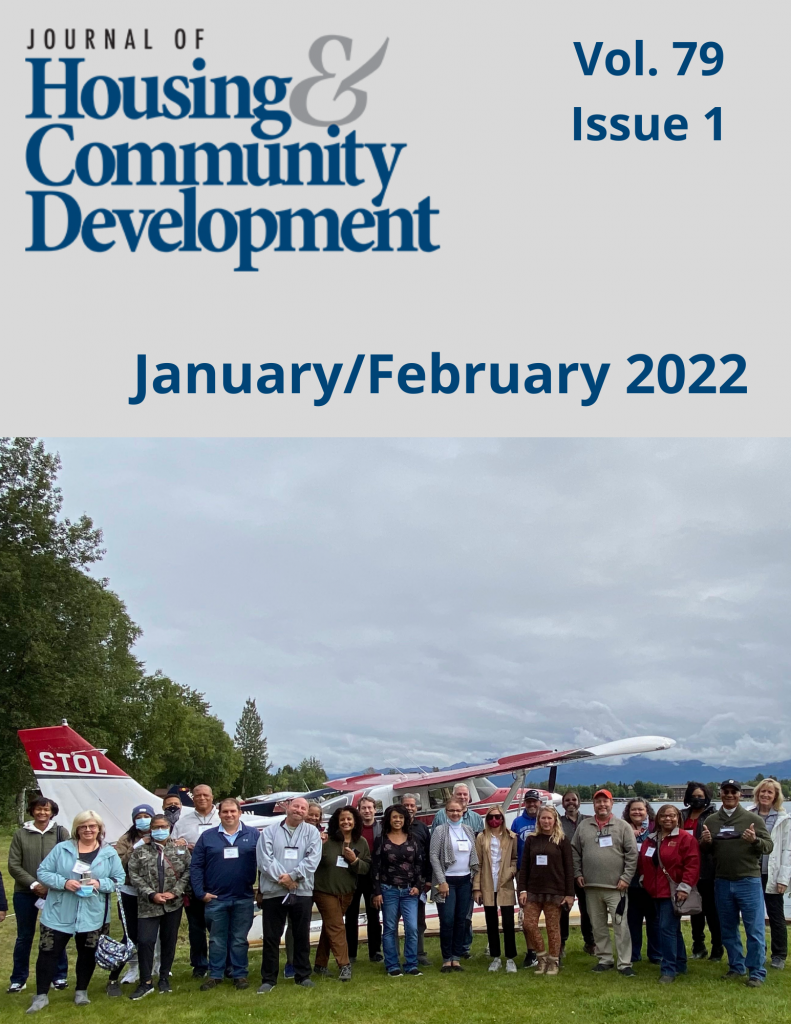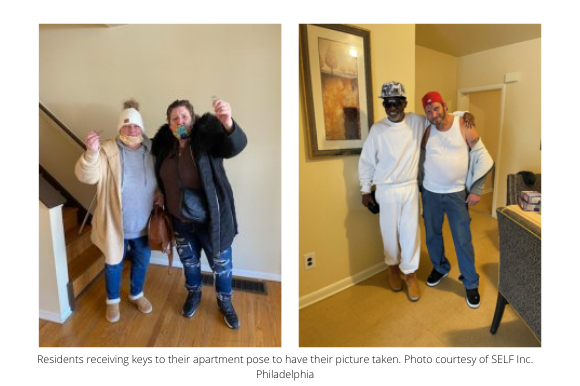NAHRO Alaska Exchange: Housing in Rural America

Housing Authorities must deal with such problems as construction, domestic violence, plumbing and homelessness. But what if we had the additional challenge of construction with the ground melting away? Domestic violence in an isolated village of 300 without road access? Plumbing with a plumber a plane flight away? Homelessness where the person is in the home? This is what Alaska’s housing authorities routinely face, with solutions that can translate for our all the nation’s housing programs, and even international housing.
In August, then NAHRO President Sunny Shaw and Senior Vice President Patricia Wells led a unique learning exchange between NAHRO members and Alaskan Native communities. As part of NAHRO’s mission to create strong and stable communities, visiting the Alaskan communities and developing the knowledge exchange in close cooperation with the Cook Inlet Housing Authority (CIHA) and the Association of Alaska Housing Authorities would be the start of this ongoing partnership. The exchange included informal discussion on Alaska Native Housing, visits to Alaska Native cultural areas and housing communities, and a series of knowledge roundtables.

2021 was also the 25th Anniversary of Congress passing the Native American Housing and Self Determination Act (NAHASDA) intended to recognize the Tribe’s sovereign rights to develop housing to meet the needs of their communities and families, and the Association of Alaska Housing Authorities has determined a need of more than 16,100 homes just to alleviate overcrowding—the rate of overcrowding throughout Alaska is greater than the rest of the United States. In 2018 the Alaska Housing Finance Corporation’s Alaska Housing Assessment reported overcrowded units at twice the national rate with “nearly half of all households in some areas being overcrowded.” The Native American Housing Block Grant (NAHBG) is the funding vehicle for housing programs in Alaska. But it has been essentially flat funded since it was passed in 1996 despite inflation, population growth and construction costs—and even transportation costs. The HUD website notes “So why, you might be asking, don’t they just build more housing? Sensible question. A map answers it. To build a house in Yakutat, you need to order the building materials – the doors, the windows, the fixtures, the whole nine yards – to be barged up from Seattle about 1,100 miles away. Once supplies arrive, you have to import electricians, plumbers, roofers, carpenters, dry-wallers and everyone else to put all those pieces together.”
Utqiagvik
At the beginning of the exchange the delegation was planned to break up into groups covering housing in Anchorage, Bethel, and Utqiagvik. My group of nine was planned to go to Utqiagvik, formerly known as Barrow and the northernmost point in the United States with a population of 4,000. Unfortunately the COVID-19 pandemic had a resurgence on the North Slope, yet we were fortunate to have Griffin Hagle, chief executive officer of the Taġiuġmiullu Nunamiullu Housing Authority (TNHA), join us in Anchorage. The TNHA is one of the 14 regional housing authorities (RHA) serving six tribes in six villages for about 300 families—these six villages are spread across 600 miles from east to west, covering a region about the size of the state of Minnesota—and none of the villages are connected by road. This is done with a full time staff of 36 from Alaska, Hawaii, the Lower 48, Korea, Samoa, Tonga, Poland, and the Philippines.

Climate Change
Climate change and the melting permafrost has significant impact on both new construction and maintenance of current homes. And everything is built on the permafrost which serves as a concrete foundation.
Accelerated by the arctic amplification effect, climate change also effects the TNHA homeownership program where residents own their homes after paying it off in 15 years. But with storm surges reclaiming the ice and further destroying permafrost, families are asking if they will be able to afford home insurance at that 15 year mark. One novel approach taken by TNHA has been to place the homes on large sleds, rather than posts, allowing the homes to be moved to safer ground as the surrounding area deteriorates. Featured on the British Broadcasting Corporation (BBC) Arctic Live program, these “sled homes” can be found on the BBC’s website Artic Live.

Overcrowding and Homelessness
Port Lay, about 200 miles south of Utqiagvik is one of the villages served by TNHA. With a population of 300, it is 75% overcrowded and 50% severely overcrowded. When someone is homeless, they cannot live outside—rather, they are brought into the homes, and homelessness and overcrowding become inseparable. In other words, homelessness masks itself as overcrowding.
The Association of Alaska Housing Authorities write of this in their report Addressing Alaska’s Housing Shortage, citing the Alaska Housing Finance Corporation’s 2018 Alaska Housing Assessment “Alaska as a whole must increase its home construction by 11% over current rate of construction. Add in the need to alleviate overcrowding (and keep up with the population changes) Alaska will need to increase home construction by 90% (over 2011-2015 five year average).” They further share that “it is common for RHAs to hear of 15-18 people residing in a 1,200 square foot home.” The need for housing is acute and Griffin said it was strongly felt by the TNHA.

Building Homes
TNHA owns about 12 – 15 homes in each village, about 15% of the community housing stock, but the challenge of building new housing is complicated not only by logistics, the homes must also be adaptable to the changing climate. The equivalent area of Minnesota is served by TNHA if Minnesota was also completely without roads. All materials and personnel must be brought in by aircraft or barges, and with winter temperatures sometimes reaching -45 F, construction and transportation must be scheduled for the summer when transport is available.
A way to address these costs in the 1970s and 1980s was through cyclical large phases of development, followed by a period of then paying off the loans. The first generation of homes such as a flintlock house built in 2010, uses a “sustainable northern shelter” design with a R-60 foam building envelope. But even with the sustainable technology of the day, it still requires 5-6,000 gallons of fuel to be flown in annually for one home.

The sixth generation homes only need 200 gallons annually of fuel. Using structurally insulated panel construction, they are portable, resting on an adjustable and insulated foundation (the sled design). They also use less windows—which must be triple paned and which add to construction expense.
Despite such care in containing window expense, the 2015 construction cost per square foot was between $448-$600. By contrast, a 2017 report by the National Association of Home Builders, while also accounting for inflation and appreciation levels, showed the range of costs in the Lower 48 at $100 a square foot in the South Region up to $155 a square foot in the Northeast Region.

Solutions
Some of the solution need is also the need of the Lower 48 housing programs. Homes need to be a size to accommodate the typical family of a single parent with three or four children and multigenerational function. A modern and reasonably accessible labor and trade force is needed. Construction needs Total Development Cost waivers. Use of consortia RHAs help leverage transportation costs. All of these challenges mean that they must tell their story and educate legislators in Washington D.C., and sometimes even in Juneau. They’ve had some success, according to Griffin. In August, Sen. Lisa Murkowski met with U.S. Secretary of Energy Jennifer Granholm in Fairbanks and also met with research scientists about the energy and home building solutions being developed in Alaska.
“We know in Alaska that we have been pioneering for a long time. But I don’t think that is well understood outside of the state,” Sen. Murkowski said as reported by The Fairbanks Daily News-Miner. The Senator went on to say that Congressional hearings and presentations cannot fully show the ingenuity of Alaskans in finding sustainable solutions for remote communities responding to extreme weather events. Sec. Granholm was looking to explore partnerships with Alaska Native communities. “Indigenous communities have been finding solutions for centuries,” she said. “We can learn from experience here.” Griffin said that rural Alaska could be the story of rural America.

Anchorage
The complete exchange roundtable took place at the Cook Inlet Housing Authority’s The Nave. The Nave was the perfect site. Previously known as “Love Church” and used by artists and musicians, it was renovated by the Cook Inlet Housing Authority and now used as a community and cultural center that hosts music, art and business events. The roundtable was hosted by CIHA President and CEO Carol Gore, her team, and other housing and community leaders, with the subject on overcrowding and homelessness and a focus on partnerships with housing providers and permanent supportive housing.
The 2011 recipient of NAHRO’s M. Justin Herman Memorial Award, Gore noted the power of relationships, such as found between the P and I of HUD PIH (Public and Indian Housing). Gore shared the story of her housing journey. Starting her career at the troubled agency, she was given a stack of papers and told to figure out what was wrong with the housing authority. She worked two years with the inspector general, reformed the team, and decided they could still do better by bringing together all the tribes and creating diverse neighborhoods. Starting with 267 units of senior housing in the 1990s, today the CIHA has built more than 1,700 energy efficient homes. Gore emphasized that the consortia model for RHAs is important, as some villages with only 200 people need the partnership help to hire experienced people for their PHA offices. Gore said the 14 RHA executive directors are all peers and diverse, but united in an advocacy voice for their programs, and she said it was amazing how much they had in common—from a small village of 200 to the 300,000 Anchorage population. They are often asked how they respond to the family need rather than the national need, and their response is to meet the need where it is, rather than trying to fit into a nationally prescribed model that does not fit everywhere. As Gore put it, don’t just look at who we serve, but look at who we don’t serve, and how do we change it.
One example of how partnering housing authorities can be successful is Hooper Bay, which had lost 15 acres of their housing and school to a 2006 fire. An isolated city of 1,000 on the western coast, they would have needed the homes built and then hauled in by barge. The housing authority did not have the resources to do this, and although it is not in CIHA’s region, both agencies partnered and leveraged CIHA’s ability to help put together the money and move the homes. The partnership still exists today.
Breaking into subgroups, my group included Sen. Murkowski’s aide, and our conversation took a deep look at community needs in isolated villages.
Families experiencing domestic violence need to have community and criminal services flown in, and the lack of housing means that some families live a long time in a domestic violence shelter. Utqiagvik, at only 4,000 people, is still a common example of creating a hub for surrounding isolated villages that need services. Telehealth has become a huge lifeline, making it more efficient when dentists and doctors must be flown in. Solutions to problems showing remarkable resiliency.
The final day was a roundtable of sharing innovation and best practices. What would we take back from the exchange? The message was the power of respect, reputation and partnerships. Everyone is an ambassador for their community, bringing your reputation to the table makes others want you to be part of the solutions. Trials and challenges must be met with grace and calm. And the importance of planning, because in Alaska your life depends on it—if something you need doesn’t get there by August, then it doesn’t get there. It is the very important story of I, of us, and of now, a story that resonates everywhere. Gore, Shaw and Wells concluded the exchange with these thoughts. We do more together. In Alaska, regardless of how remote our partners are, they all came together to tell their story. And now this knowledge exchange with NAHRO and its Alaska partners has grown our housing family in continuing to build the friendship and relationship on our shared advocacy path. We feel the pressure to get it right for those that will follow us. We feel the urgency to share—and doing so together is the better path.
In 2021, Alan Zais was Chair of the NAHRO International Research and Global Exchange Committee (IRGE) in representing the committee to the Alaska Knowledge Exchange.
Sources
Kunze, J. (07/01/2020). As the Arctic warms, the Inupiat adapt. High Country News. Retrieved 09/08/21 from https://www.hcn.org/issues/52.7/indigenous-affairs-climate-change-what-choice-do-we-have.
Addressing Alaska’s Housing Shortage. Association of Alaska Housing Authorities. Retrieved 09/08/21 from 1c1463_81961be5b19c416584caf74b6ba7c777.pdf (aahaak.org).
Siniavskaia, N. (10/29/2018). Sale and Contract Prices per Square Foot in 2017. Eye On Housing. National Association of Home Builders Discusses Economics and Housing Policy. Retrieved 12/18/21 from Sale and Contract Prices per Square Foot in 2017 | Eye On Housing.
Hersey, L. (08/15/2021). Energy Secretary to Alaska, ‘You have the solutions.’ Fairbanks Daily News-Miner. Retrieved 12/18/21 from Energy Secretary to Alaska: ‘You have the solutions’ | Local News | newsminer.com.
Source: Association of Alaska Housing Authorities. Retrieved 12/28/21 from Advocacy | Association of Alaska Housing Authorities (aahaak.org)
U.S. Department of Housing and Urban Development. (04/21/2021). Alaska Stories, On The Way? Retrieved 12/28/21 from ON THE WAY? | HUD.gov / U.S. Department of Housing and Urban Development (HUD)
More Articles in this Issue
Social Media Strategies for Housing Agencies
Social media can be a valuable tool for a housing agency or nonprofit organization. It…Shared Housing Tackles Loneliness in Homeless Services
*This article was previously published in Shelterforce Magazine on Jan. 12, 2022. You can view…


